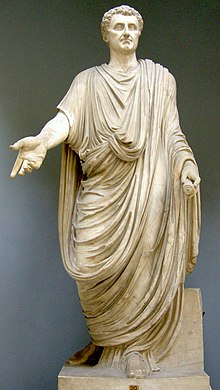
Back Nerva Afrikaans Nerva AN نيرفا Arabic نيرفا ARZ Nerva AST Nerva Azerbaijani نروا AZB Нерва Byelorussian Нерва Bulgarian Nerva Breton
| Nerva | |||||
|---|---|---|---|---|---|
 | |||||
| Roman emperor | |||||
| Reign | 18 September 96 – 27 January 98 | ||||
| Predecessor | Domitian | ||||
| Successor | Trajan | ||||
| Born | Marcus Cocceius Nerva 8 November 30 AD Narni, Italy | ||||
| Died | 27 January 98 AD (aged 67) Gardens of Sallust, Rome, Italy | ||||
| Burial | Mausoleum of Augustus, Rome | ||||
| Issue | Trajan (adoptive) | ||||
| |||||
| Dynasty | Nerva–Antonine | ||||
| Father | Marcus Cocceius Nerva | ||||
| Mother | Sergia Plautilla | ||||
| Roman imperial dynasties | ||||||||||||||
|---|---|---|---|---|---|---|---|---|---|---|---|---|---|---|
| Nerva–Antonine dynasty (AD 96–192) | ||||||||||||||
| Chronology | ||||||||||||||
|
||||||||||||||
| Family | ||||||||||||||
| Succession | ||||||||||||||
|
||||||||||||||
Nerva (/ˈnɜːrvə/; born Marcus Cocceius Nerva; 8 November 30 – 27 January 98) was a Roman emperor from 96 to 98. Nerva became emperor when aged almost 66, after a lifetime of imperial service under Nero and the succeeding rulers of the Flavian dynasty. Under Nero, he was a member of the imperial entourage and played a vital part in exposing the Pisonian conspiracy of 65. Later, as a loyalist to the Flavians, he attained consulships in 71 and 90 during the reigns of Vespasian and Domitian, respectively. On 19 September 96, Domitian was assassinated in a palace conspiracy involving members of the Praetorian Guard and several of his freedmen. On the same day, Nerva was declared emperor by the Roman Senate. As the new ruler of the Roman Empire, he vowed to restore liberties which had been curtailed during the autocratic government of Domitian.
Nerva's brief reign was marred by financial difficulties and his inability to assert his authority over the Roman army. A revolt by the Praetorian Guard in October 97 essentially forced him to adopt an heir. After some deliberation Nerva adopted Trajan, a young and popular general, as his successor. After barely fifteen months in office, Nerva died of natural causes on 27 January 98. Upon his death he was succeeded and deified by Trajan. Although much of his life remains obscure, Nerva was considered a wise and moderate emperor by ancient historians. Nerva's greatest success was ensuring a peaceful transition of power after his death by selecting Trajan as his heir, thus founding the Nerva–Antonine dynasty. He was the first of the Five Good Emperors.
- ^ Cooley, Alison E. (2012). The Cambridge Manual of Latin Epigraphy. Cambridge University Press. p. 491. ISBN 978-0-521-84026-2.